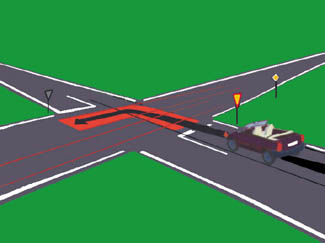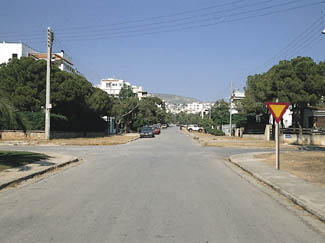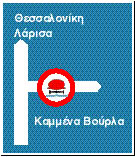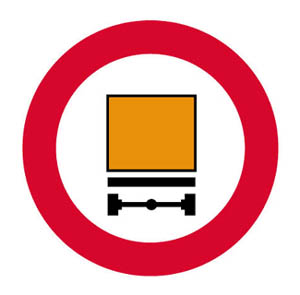1. A policeman is regulating the traffic at a crossroad where there are also traffic signs that regulate priority. What should you do?
-
You should exclusively follow the traffic signs that regulate priority.
-
You should follow the signals of the policeman.
2. If the traffic policeman is waiving at night a red light to your direction, you must:
-
Turn right.
-
Stop.
-
Continue straight ahead.
3. How should you react to the instructions of the traffic policeman?
-
You must always follow them.
-
You must follow them when they agree with the traffic signs.
4. When are you allowed to pass a railway crossing with a flashing light which a train has just passed?
-
When the opposite traffic starts, even if the red flashing light is still on.
-
As soon as the train passes, even if the red flashing light is still on.
-
When the red flashing light goes off.
5. You wish to cross an intersection. In which case should you not enter the intersection if the traffic light is green?
-
When you are obliged to wait at the intersection, because the traffic is blocked in front of you.
-
When at the intersection there is a “STOP” traffic sign.
6. A traffic policeman regulates the traffic at a crossroads, although the traffic lights work. You must comply with:
-
The traffic lights.
-
The signals of the traffic policeman.
7. Traffic signs with a red circular outline indicate:
-
Information.
-
Limitation or prohibition.
-
Notice of dangerous places.
8. Does these yellow lines (mesh) oblige vehicles to wait until they turn?
9. You are driving the red convertible. The blue car is coming at a high speed:
-
You should be ready to stop, because it is always possible that your right of way may be violated.
-
You should drive towards the crossroads after warning through the horn, because you have the right of way.
10. In this case:
-
You must slow down.
-
You must pass.
-
You must stop.
11. When turning at a crossroads, you are leaving the dangerous area:
-
As soon as you have developed the speed at which the vehicles in the street you entered are moving.
-
As soon as you finish your turn.
12. When you meet this traffic sign:
-
You should give priority at the next crossroads.
-
At the next crossroads you will have the right of way.
13. At a crossroad where the traffic light is flashing round red, what should you do?
-
You should give way to pedestrians.
-
You should immobilise your vehicle.
-
You should reduce speed and move carefully.
14. This traffic sign informs you of:
-
A danger and an intersection where you have priority.
-
A danger and an intersection where priority from the right applies.
15. Traffic signs with a blue circular background indicate:
-
A notice of dangerous positions.
-
A prohibition.
-
An obligation.
16. When you meet this traffic sign:
-
You must give way to the vehicles that come from the left and right.
-
You must stop at the dividing line.
17. If the direction indicators of your vehicle do not work, how will you warn of your intention to turn left?
-
By extending your left arm.
-
By raising your left arm vertically.
-
By using the brake lights repeatedly.
18. At a circular junction:
-
You should converge on the centre if your exit from the junction is on the left of the extension of the road axis from which you entered the junction.
-
Whichever is the exit that you will follow, you should first pass from the internal lane of the junction.
19. At a level railway crossing where the red light flashes and the mobile barrier has not been lowered yet, what should you do?
-
Continue your course as long as the barrier is still open.
-
Wait in front of the warning traffic sign.
-
Pass the railway crossing as long as no train appears to be coming.
20. At a circular junction:
-
You can stay on the right up to the exit, if you do not know your exit.
-
Whichever is the exit you will follow, you should first pass from the internal lane of the junction.
21. What does this traffic sign mean?
-
Compulsory by-pass for vehicles carrying hazardous loads.
-
Compulsory by-pass for vehicles carrying explosive or inflammable materials.
-
No entry to vehicles carrying explosive or inflammable materials.
22. What does this traffic sign mean?
-
Caution! Vehicles carrying hazardous materials may cause water pollution.
-
Vehicles carrying hazardous loads are prohibited from following the direction.
-
Vehicles carrying hazardous loads must turn left.
23. What does this traffic sign mean?
-
Vehicles carrying hazardous loads are prohibited from following the direction.
-
Vehicles carrying hazardous loads must turn left.
-
Caution! Vehicles carrying hazardous materials may cause water pollution.
24. What does this traffic sign mean?
-
Vehicles carrying hazardous loads are prohibited from turning right.
-
Vehicles carrying explosive or inflammable materials must turn right.
-
Vehicles carrying hazardous loads must turn right.
25. Which vehicles does this traffic sign concern?
-
Vehicles carrying over a certain quantity of materials that may cause water pollution.
-
Vehicles carrying over a certain quantity of explosive or inflammable materials.
-
Vehicles carrying hazardous materials.
26. Which vehicles does this traffic sign concern?
-
Vehicles carrying over a certain quantity of materials that may cause water pollution.
-
Vehicles carrying hazardous materials.
-
Vehicles carrying over a certain quantity of explosive or inflammable materials.
27. Which vehicles does this traffic sign concern?
-
Vehicles carrying over a certain quantity of explosive or inflammable materials.
-
Vehicles carrying hazardous materials.
-
Lorries carrying hazardous loads.
28. What does the green traffic light in the shape of a vertical arrow showing downwards mean?
-
You are allowed to drive in all lanes of the road.
-
You are allowed to drive in the lane over which the arrow is.
-
You are not allowed to drive in the lane over which the arrow is.
29. Reaching the traffic light at a speed of 50 km/h, it changes to amber:
-
You should brake hard and stop in all cases.
-
Since you are very close to the traffic light, you should go past it so as to avoid possible dangers from the sudden stop.
30. Can you find an acceleration lane only in a motorway?
















